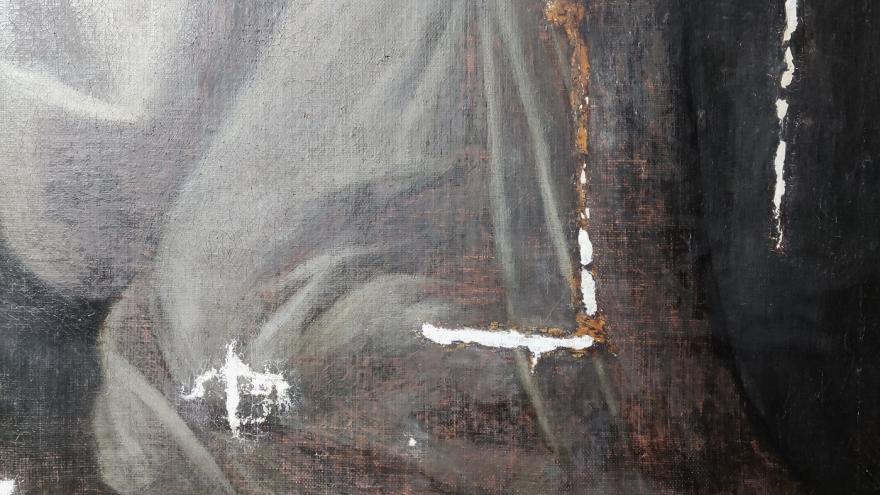
Restoration of the painting of Saint Bernard embracing the crucified Christ from the Convent of the Discalced Trinitarians
17th century oil painting
The canvas Saint Bernard embracing the crucified Christ It is part of a collection of paintings with religious themes that are kept in the Convent of the Barefoot Trinitarians (Monastery of San Ildefonso and San Juan de la Mata) in Madrid. It was painted in the year 1680 by Alonso del Arco (Madrid, 1635-1704) as confirmed by the author's signature, and represents one of the miracles of Saint Bernard, collected in Vita et miracula D. Bernardi Cleravalensis Abbatis, a work published in Rome in 1587. The source of inspiration for Alonso del Arco's composition seems to have been the panel painted by Angelo Nardi for the baldachin of the church of the Monastery of San Bernardo in Alcalá de Henares.
Conservation status of the work
The work had a frame in good condition, except for slight wear and loss in the decoration of the carving, with two of the acanthus scrolls missing from the corners. In addition, it suffered from oxidation of the protective varnishes, accumulation of dust and the fixation of a large number of fly droppings on the surface.
The frame is preserved intact, with the assemblies in functional condition and without structural problems, although a dense layer of dirt was embedded in its surface.
Regarding the canvas, numerous deteriorations and breaks were observed, which gave rise to losses of preparation and paint and which have been attempted to be alleviated by applying reinforcement patches. The paint was quite dirty, in addition to numerous traces of adhesive from previous patches, cracks and raised edges in the form of ridges. Likewise, in the past abrasive cleaning was carried out that did not favor the conservation of the paint.
Previous restorations of the canvas have sometimes been inadequate, invading the original paint and producing visible bulges that caused loss of polychromy. In some cases the repainting was cracked and partially lost.
restoration project
In the restoration process, the following actions have been carried out:
- Framing System Disassembly after removing the nails that joined the canvas and frame.
- Cleaning surface by micro-vacuuming the front and back of the painting, frame included and provisional protection of pictorial film through the wallpapering procedure. After separating the frame from the canvas, a thorough mechanical cleaning was carried out.
- Elimination of old interventions made on the support, sitting of the pictorial layer, reintegration of support losses and consolidation of the same. replacing the frame system with a rigid support system.
- Removing wallpaper and deep cleaning of the pictorial film and removal of oxidized varnishes. The cleaning process revealed the artist's signature, given that the canvas had undergone extensive repainting.
- Reintegration of pictorial matter following the principles of reversibility, notoriety and minimal intervention and protection with varnish, recovering the original saturations.
- frame treatment through cleaning, consolidation and reintegration of gilding and final protection. In the subsequent placement of the frame, materials more in line with the preservation of the work have been used, such as metal plates and screws, replaced by the traditional system of nails placed on the bias.
With the treatments applied, both the canvas and the frame, the original properties of the work have been recovered, allowing values of great historical-artistic relevance to be appreciated.
Technical sheet
- Author
Alonso del Arco (1635-1704)
- Dating:
1680. Baroque
- Material and technique:
Oil on canvas
Cloister of the Monastery of San Ildefonso and San Juan de Mata or Convent of the Discalced Trinitarians
Lope de Vega Street No. 18, Madrid
The Church of the Monastery of San Ildefonso and San Juan de Mata was declared a National Monument by Royal Order of September 17, 1921, and the Convent of the Discalced Trinitarians on November 11, 1943.
By Order 19/2017 of the Minister of Culture, Tourism and Sports, the protected area of the Convent of the Discalced Trinitarian Nuns was delimited.
Paint Saint Bernard embracing Christ Crucified It is a property protected by the Community of Madrid.
- Work team:
Mercedes del Pino Peño
- Date of the intervention:
2023
Bibliography:
- Aranjo y Costa, J. “The convent of the Trinitarias.” In HL Madrid, October 15 of 1951.
- N. Galindo. (1972) “Alonso del Arco”. Spanish Art Archive, XLV, pp. 347-385.
- Menéndez Pidal, Ramón: "The convent of the Trinitarias of Madrid", in Bulletin of the Royal Academy of History, t. 79, pp. 97-99 and 474-74, and t. 112, 1943, pp. 141-142.
- Tovar Martín, V. (1990). “The Monastery of the Discalced Trinitarian Sisters of San Ildefonso in Madrid”. Spanish Art Archive, No. 251, pp. 401-418.
- Perez Sanchez, Alfonso E. (1992). Baroque painting in Spain. 1600–1750. Madrid. Chair Editions.







